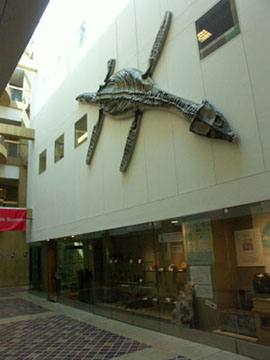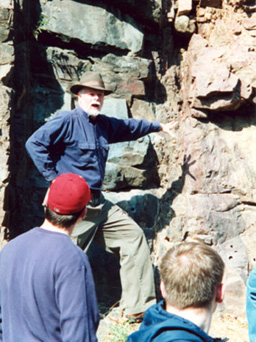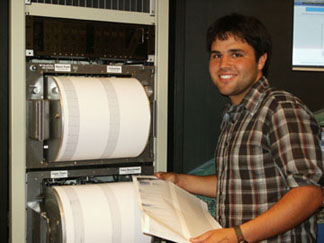Geotimes

Untitled Document

Feature
Broadening horizons
for students
Naomi Lubick
Sidebar: Student
outlooks

In 2002, the Cornell University Department of Geological Science broadened
into the Department of Earth and Atmospheric Sciences, bringing in the atmospheric
group from another department. At the time, the geology program had only a few
undergraduate majors. Now, the new department administers 80 to 100 undergraduates
in three majors — Geological Sciences, Science of Earth Systems and Atmospheric
Science.
Snee Hall is home to Cornell University’s Department of Earth and Atmospheric
Sciences. Since broadening its subject base in 2002, the department has greatly
increased its number of majors. Photo by Lynda Swafford, Cornell University.
Each major has a separate focus. For example, the Science of Earth Systems major
takes an approach that highlights interactions among the solid earth, the atmosphere
and the oceans. The major draws students from the Colleges of Engineering, Arts
and Sciences, and Agriculture and Life Sciences. “It makes a stronger department,”
says Kerry Cook, an atmospheric scientist who helped head up the recent metamorphosis.
“You have to add other elements.”
That theme seems to be more common among small geology departments at all schools,
from private Ivies to state-run universities, which have been under financial
pressures. The shift, some say, is headed toward environmental sciences or a
softening of the geological sciences — but some departments, like Cornell’s,
that have undergone successful transitions lately have opted for more rigor,
yet more breadth. Those that have the option of combining with another department
or that redefine themselves in some way may end up better off than when they
started.
Transformation
 At the University of Missouri at Rolla
and Michigan Technological University (Michigan Tech), it was the threat to
another department that created the right circumstances for a merger of related
geosciences at each institution. The two technology-oriented schools are state-funded,
and such public institutions have been feeling the crunch. Southeast Missouri
State University in Cape Girardeau recently shut down its geology department
because of funding issues, among others (see Geotimes,
May 2004, and sidebar in previous feature).
At the University of Missouri at Rolla
and Michigan Technological University (Michigan Tech), it was the threat to
another department that created the right circumstances for a merger of related
geosciences at each institution. The two technology-oriented schools are state-funded,
and such public institutions have been feeling the crunch. Southeast Missouri
State University in Cape Girardeau recently shut down its geology department
because of funding issues, among others (see Geotimes,
May 2004, and sidebar in previous feature).
Geologist Jay Gregg lectures before a roadcut along Highway 72 in eastern Missouri.
Gregg chairs the newly formed Department of Geological Sciences & Engineering
at the University of Missouri at Rolla. Photo by Katherine Mattison, University
of Missouri at Rolla.
At Rolla, the faculty themselves started the process of merging their geology
department with geological and petroleum engineers last year. “Rather than
fight what appeared to be inevitable,” says Jay Gregg, a geologist who
chairs the new department, the faculty “embraced the change and tried to
combine … with as little disruption as possible.” Gregg and his colleagues
admit it was an interesting undertaking, considering the disparate views of
engineering and geology cultures. From six departments, the university’s
School of Materials, Energy & Earth Resources went to three, with the new
configurations becoming official on July 1.
Over the past 30 years, Rolla’s school of mines had seen slightly shrinking
enrollments. “It’s not easy to get 17- and 18-year-olds interested
in mining. They’re interested in computers and communication technologies,”
says Jeff Cawlfield, a geological engineer who is associate chair of the new
department. But “we don’t need everybody to be an information technology
person,” he continues, and with the bursting of the IT bubble several years
ago, “we’re seeing an uptick, especially in petroleum.”
The enrollment in petroleum engineering has increased — but only from 5
new freshmen to 10 a year. “That’s a doubling for us, but to the administration,
that’s not much,” Cawlfield says. “We point out that although
these are small programs, they are critical” because the department’s
graduates go to major oil companies, where they play an important role.
“We had to concentrate on recruiting undergraduate majors,” Gregg
says. With the departmental mergers and a recent increase in student interest,
the department is now over 80 majors strong.
Michigan Tech faced a similar situation, says Wayne Pennington, chair of its
newly merged department, except that the main change came from the top down.
Like most mining departments, Pennington says that Michigan Tech’s was
experiencing declining enrollment. To save on administrative costs, he says,
the university merged the mining engineering department with the department
that was then geological engineering, geology and geophysics and, within the
next year, terminated their undergraduate mining engineering degree. The merger
brought a few more students into the new department, and despite losing faculty
members to other departments, only one tenure-track position was eliminated
altogether.
“The closure of mining served as a serious wakeup call to us and other
programs at other universities, programs like us,” Pennington says. “At
any university, any small department has to be aware that at some occasion the
administration simply must consider their closure. …Whether or not that
was a serious consideration of our administration, we will never know.”
But in the midst of such upheaval, the Michigan Tech geology and engineering
faculty took “a hard look at what our strengths were and weaknesses,”
he says. For a routine external review, the faculty prepared very carefully,
Pennington says, and “instead of a basket of problems, we presented a basket
of scenarios” for improvement.
Self-scrutiny played a similar role for the geologists and engineers at the
University of Missouri at Rolla. Now that the budget situation for the Missouri
university system has changed, the department is “feeling less under the
gun,” Cawlfield says, and the consolidation provides some protection, particularly
because of the faculty’s willingness to examine their inefficiencies and
improve them. “We’ve done in good faith what we could do,” he
says.
Survival
“What led us to survive is the fact that the University of Missouri-Rolla
is not a large university, it’s a small engineering school,” Gregg
says. He points out that Southeast Missouri State is a much larger school, and
its geology department was still at higher risk.
“The merger made us the largest geological department in the state of Missouri;
when states look to cut, it’s better to be a bigger than a smaller program,”
he says, combining an active research community with turning out a lot of students
with degrees. “If you’re not going to do that, you’re not going
to be very survivable.”
For Cornell the issue was less about survivability and more about general departmental
health. A school of 16,000, Cornell has a long history of geologic prestige
and would never completely eliminate its geology department, Cook says: “There’s
some kind of immunity there,” one that atmospheric sciences, for example,
may not have. Nevertheless, she says, “the thing that really drove the
change was the needs of the undergraduate program to develop a more earth systems
approach,” and the interdisciplinary change has been “exciting.”
All of these transformed departments, however, have one strong commonality:
The faculty decided that they would maintain scientific rigor. “We realized
we weren’t going to be able to dumb down our programs,” Gregg says,
and still ensure that their graduates continue to be hired by mining, engineering
and oil companies — something he says other geology programs have done
to their own detriment.
Departments can essentially take two paths, one that maintains scientific rigor
by increasing the breadth of the science studied, and another that blends in
policy or social science. In Cornell’s case, Cook says that the new department
was able to maintain scientific rigor while still allowing students to take
elective courses that blend in social science. Thus, some of Cornell’s
earth science majors, who take interdisciplinary science courses, may go to
policy programs or environmental law after they finish.
For threatened departments, knowing when to shift into survival mode is not
necessarily clear, however (see story). While a variety
of methods and behaviors can ensure a department’s continued existence,
perhaps in the end, it comes down to a more fickle deciding factor: student
preference.
For example, Pennington says, the Michigan Tech department has maintained its
scientific rigor, combined with other fields and conducted sincere self-evaluation
and made appropriate changes. Nevertheless, “that doesn’t mean we
haven’t been changing our emphasis, as the student clientele change their
emphasis,” he says. Adding to their strong programs in petroleum and mineral
resources and in groundwater engineering, Michigan Tech recently adopted a natural
hazards program with a Peace Corps volunteer component, and historically the
department includes an earth science teachers program.
“Every case like this,” Pennington says, “is a unique case, with
different conditions.”
| Student
outlooks
 Geotimes spoke to
a handful of geology students to see what they were thinking about their
futures in the field. Like most students in any discipline, they are grappling
with the difficult question of what’s next. Geotimes spoke to
a handful of geology students to see what they were thinking about their
futures in the field. Like most students in any discipline, they are grappling
with the difficult question of what’s next.
Elliot Grunewald, who will start his senior year at Brown University in
Providence, R.I., this fall, interned this summer at the U.S. Geological
Survey in Menlo Park. Although he worked on earthquake hazards, he will
probably pursue geophysics and hydrology. Photo by Serkan Bozkurt, USGS.
“The job market is kind of an uncertain thing,” says Scott Miller,
a graduate student at Pennsylvania State University who hopes to be done
in December. “You never know what’s [going to be] available.”
When Miller started his graduate work in tectonic geomorphology five years
ago, the market was strong, he says, “but you wonder how long that
wave of hiring will last.”
Of his classmates, Miller says that some recent graduates have taught
for several years, covering for people on sabbatical or in the field,
or taken on post-doctoral positions, eventually getting teaching positions.
And while he has interned with ExxonMobil, which has shown interest in
his computer modeling work, he sounds less sure about working for industry
than some of his other classmates might be.
“I like many aspects of the [industry] environment — the data
richness of it, that they do pay you to do something you enjoy,”
he says, but “a big concern of mine is quality of life. I do geology
because of that: I like the outdoors. Houston would be a shock to me.”
To that end, Miller says he may have to readjust his goals, whether he
ends up pursuing an academic or industry position. “You may end up
where you didn’t really think you would be,” he says.
Elliot Grunewald, soon to be a senior geology major at Brown University,
in Providence, R.I., is likewise “a little concerned about what’s
out there just in terms of jobs,” he says. “It’s a little
disconcerting when people ask me, as I get closer and closer to graduating,
what I’m going to do with [a geology degree] and I don’t have
an answer.” On the other hand, Grunewald says he is confident he
will find something that interests him that is geology related, noting
that Brown’s geology students in the past have received assistance
from the university’s career center.
Grunewald discovered geology in his first year of high school, through
an engaging earth science teacher. But Grunewald wasn’t sure he himself
would pursue it, until he found hydrology and geophysics. “One of
my original concerns with geology was just how useful it is in general
with tackling modern problems and producing real results, real impacts,”
he says, “and applied geophysics showed me the power of geology to
do something more than just say what happened to an area 10 million years
ago.”
Grunewald will take his first hydrology course in his senior year, after
having spent this summer interning with the U.S. Geological Survey (USGS),
working on estimating earthquake hazards for Tokyo using historical data.
Julie Fosdick, who graduated last spring with her bachelor’s degree
in geology from the University of California, Santa Barbara, has a bit
more time to explore her career options, as she plans to stay in the academic
realm of geology. She will start a master’s program this fall at
Stanford University, and once she figures out her thesis topic, she will
most likely follow through with a Ph.D. “I would like to teach, and
I would like to research,” she says.
Of the dozen or so students who graduated with her, Fosdick says most
were interested in “the academic component,” with a few going
to industry, either oil or environmental. One classmate is pursuing a
teaching certificate for high school earth science, and another took an
internship at USGS, biding his time before deciding to apply to graduate
school or not.
Fosdick is positive about her academic future. “I’m anticipating
there being openings” once she is ready to look for a job, but after
her Ph.D., she says, “my next step would be a post-doctoral research
position,” something a newly minted geology Ph.D. may not have done
a decade ago.
NL
|
Lubick
is a staff writer for Geotimes.
Links:
"Geology
cut in Missouri," Geotimes, May 2004
"Building Geology for the Future: Cui
bono?" Geotimes, September 2004
"The numbers," sidebar,
Geotimes, September 2004
Back to top
 At the University of Missouri at Rolla
and Michigan Technological University (Michigan Tech), it was the threat to
another department that created the right circumstances for a merger of related
geosciences at each institution. The two technology-oriented schools are state-funded,
and such public institutions have been feeling the crunch. Southeast Missouri
State University in Cape Girardeau recently shut down its geology department
because of funding issues, among others (see Geotimes,
May 2004, and sidebar in previous feature).
At the University of Missouri at Rolla
and Michigan Technological University (Michigan Tech), it was the threat to
another department that created the right circumstances for a merger of related
geosciences at each institution. The two technology-oriented schools are state-funded,
and such public institutions have been feeling the crunch. Southeast Missouri
State University in Cape Girardeau recently shut down its geology department
because of funding issues, among others (see Geotimes,
May 2004, and sidebar in previous feature). 

 Geotimes spoke to
a handful of geology students to see what they were thinking about their
futures in the field. Like most students in any discipline, they are grappling
with the difficult question of what’s next.
Geotimes spoke to
a handful of geology students to see what they were thinking about their
futures in the field. Like most students in any discipline, they are grappling
with the difficult question of what’s next.